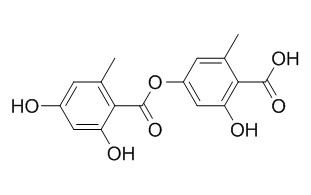Lecanoric acid
Lecanoric acid shows antioxidant activity with an IC50 value of 79-95 ug/ml, it at 100 ug/ml conc. shows high growth stimulating activity in terms of increased dry matter of biomass (56.08 mg) of L. casei.Lecanoric acid analogues antagonize several enzymic and cellular effects of the tumour promoter. Lecanoric acid analogues also inhibit prostaglandin synthetase and delayed-type hypersensitivity responses against sheep red blood cells in mice.
Inquire / Order:
manager@chemfaces.com
Technical Inquiries:
service@chemfaces.com
Tel:
+86-27-84237783
Fax:
+86-27-84254680
Address:
1 Building, No. 83, CheCheng Rd., Wuhan Economic and Technological Development Zone, Wuhan, Hubei 430056, PRC
Providing storage is as stated on the product vial and the vial is kept tightly sealed, the product can be stored for up to
24 months(2-8C).
Wherever possible, you should prepare and use solutions on the same day. However, if you need to make up stock solutions in advance, we recommend that you store the solution as aliquots in tightly sealed vials at -20C. Generally, these will be useable for up to two weeks. Before use, and prior to opening the vial we recommend that you allow your product to equilibrate to room temperature for at least 1 hour.
Need more advice on solubility, usage and handling? Please email to: service@chemfaces.com
The packaging of the product may have turned upside down during transportation, resulting in the natural compounds adhering to the neck or cap of the vial. take the vial out of its packaging and gently shake to let the compounds fall to the bottom of the vial. for liquid products, centrifuge at 200-500 RPM to gather the liquid at the bottom of the vial. try to avoid loss or contamination during handling.
Phytochem Anal.2021, 32(6):970-981.
J Ethnopharmacol.2019, 236:31-41
Tropical J. of Pha. Research2017, 16(3):543-552
Immunopharmacol Immunotoxicol.2024, 46(4):496-508.
Heliyon2022, 8(2):e08866.
J of Advanced Scientific R.2020, 11(3), p109-120.
Biomed Pharmacother.2024, 173:116319.
Environ Toxicol.2023, 23929.
iScience.2024, 4790628.
Chemistry of Natural Compounds2020, 56,423-426
Related and Featured Products
Biochem Biophys Res Commun. 1983 Feb 10;110(3):733-9.
Inhibition of histidine decarboxylase and tumour promoter-induced arachidonic acid release by lecanoric acid analogues.[Pubmed:
6404261]
METHODS AND RESULTS:
Lecanoric acid analogues containing benzanilide structure inhibited histidine decarboxylase and arachidonic acid release from the cell membrane phospholipids induced by a tumour promoter, 12-O-tetradecanoylphorbol-13-acetate. But they did not inhibit cellular binding of phorbol-12,13-dibutylate. Lecanoric acid analogues also inhibited prostaglandin synthetase and delayed-type hypersensitivity responses against sheep red blood cells in mice.
CONCLUSIONS:
Thus, Lecanoric acid analogues antagonized several enzymic and cellular effects of the tumour promoter.
J Food Sci Technol. 2014 Oct;51(10):2624-31.
Growth promoting effects of some lichen metabolites on probiotic bacteria.[Pubmed:
25328204]
METHODS AND RESULTS:
The lichen metabolites showed antioxidant activity with an IC50 values (μg/ml); Lecanoric acid 79-95, salazinic 88-108, atranorin 100-116 and consalazinic acid 119-125. As far as the growth promoting effects of lichen metabolites on L. casei is concerned, Lecanoric acid at 100 μg/ml conc. showed high growth stimulating activity in terms of increased dry matter of biomass (56.08 mg) of L. casei. Other lichen metabolites; salazinic acid, atranorin and consalazinic acid produced relatively less dry biomass 43.98 mg, 41.1 mg, 40.68 mg, respectively. However, standard antioxidants butylated hydroxyanisole (BHA), butylated hydroxytoluene (BHT) and Trolox after 36 h produced 39.04-47.81 mg dry biomass.
CONCLUSIONS:
At lower pH the growth promoting activity of lichen metabolites was found stable.



